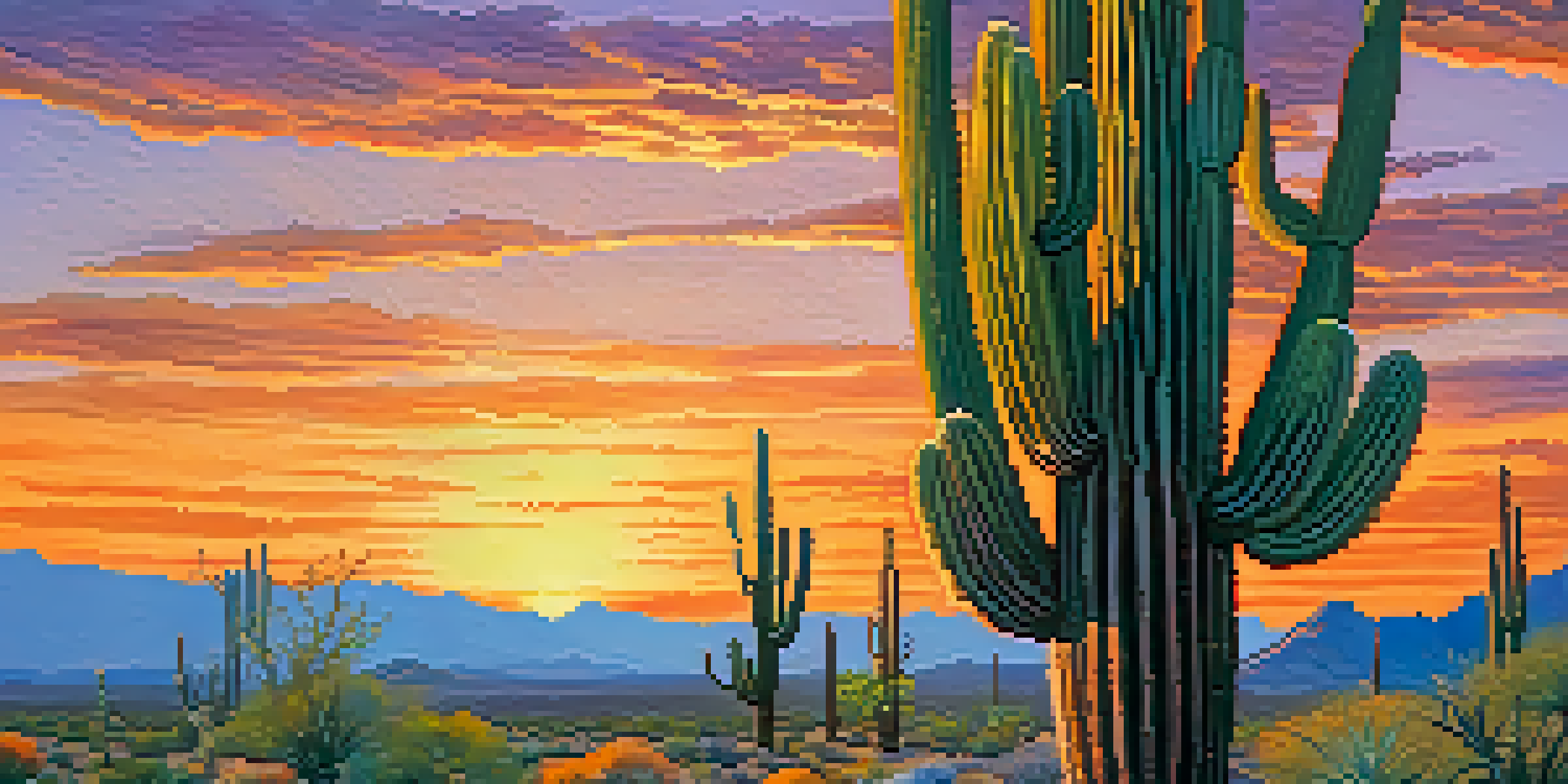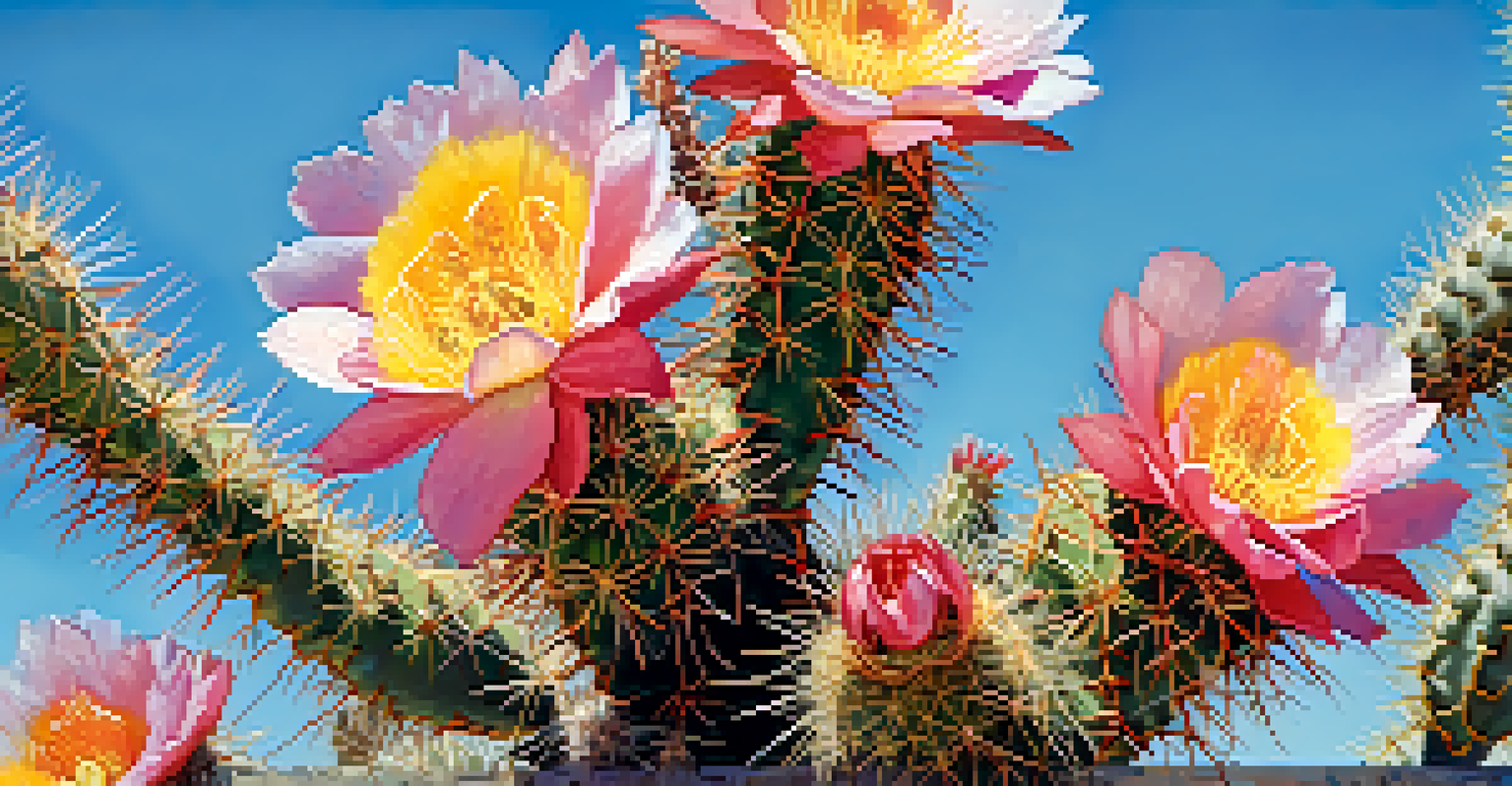Top 10 Native Plants You Can Find in Arizona's Desert

Saguaro Cactus: The Icon of Arizona's Desert
The Saguaro cactus is perhaps the most recognizable symbol of the American Southwest. Towering up to 40 feet tall, these majestic plants can live for over 150 years, making them a true desert veteran. With their distinct arm-like branches reaching towards the sky, they not only provide a stunning sight but also crucial habitats for various wildlife.
The desert is a place of great beauty, but it is also a place of great adversity. The plants that thrive here are the true survivors.
These giants bloom in late spring, showcasing beautiful white flowers that open at night and close by midday. They serve as a vital food source for bees and other pollinators, emphasizing the interconnectedness of desert life. The Saguaro cactus also stores water, helping it survive in the extreme heat and drought conditions typical of Arizona's desert.
If you're exploring the Sonoran Desert, keep an eye out for these remarkable cacti. Just remember, they are protected by law, so admire them from a distance and appreciate their beauty in their natural habitat!
Creosote Bush: The Resilient Survivor
The Creosote bush is a true desert survivor, known for its distinctive smell after rain. This evergreen shrub can live for over 11,000 years, making it one of the oldest living organisms on Earth. Its small, yellow flowers bloom in early summer, adding a splash of color to the arid landscape.

What makes the Creosote bush particularly interesting is its ability to survive in the harsh desert climate. Its leaves have a waxy coating that reduces water loss, and it has a deep root system that accesses moisture far below the surface. This plant is a fantastic example of adaptation, showcasing how life can thrive in even the toughest conditions.
Desert Plants Show Incredible Resilience
Many desert plants, like the Saguaro cactus and Creosote bush, have adapted uniquely to survive harsh climates and extreme conditions.
In addition to its resilience, the Creosote bush is also a vital part of the desert ecosystem. It provides habitat and food for many insects and birds, proving that even in a harsh environment, life finds a way to flourish.
Paloverde: The Green Tree of the Desert
Paloverde trees are known for their unique green bark and delicate yellow flowers that bloom in spring. These trees are among the most common in Arizona's deserts and play an essential role in the ecosystem. Their green bark allows them to photosynthesize, even when they lose their leaves during dry periods.
In every walk with nature, one receives far more than he seeks.
Not only do Paloverde trees provide shade and shelter for wildlife, but they also improve soil quality through nitrogen fixation. This process enhances the nutrient content of the soil, making it more fertile for other plants. Their ability to thrive in harsh conditions makes them a true testament to nature's ingenuity.
If you're hiking in the desert, you'll likely encounter these striking trees. Their vibrant blooms are a beautiful reminder of life amid the arid landscape, bringing a splash of color to the otherwise muted surroundings.
Agave: The Desert's Succulent Wonder
Agave plants are known for their rosette shape and thick, fleshy leaves that store water. These succulents are well-adapted to the desert environment, thriving in dry conditions where many other plants fail. Some species of Agave can live for decades before flowering, which can be a spectacular sight as they send up a tall stalk filled with blossoms.
Beyond their striking appearance, Agaves have many uses. Indigenous peoples traditionally used the fibers to make ropes and textiles, while the sap can be fermented to produce beverages like tequila. This versatility makes Agave an essential plant in both cultural and ecological contexts.
Wildflowers Bring Life to the Desert
Each spring, the Sonoran Desert transforms as vibrant wildflowers bloom, providing crucial food sources for pollinators and enhancing the ecosystem.
When you spot an Agave in the wild, take a moment to appreciate its resilience and beauty. They are not just decorative plants; they play a vital role in the desert's biodiversity.
Sonoran Desert Wildflowers: Nature's Color Palette
Every spring, the Sonoran Desert bursts into color as wildflowers bloom, creating a breathtaking landscape. Species like the Desert Marigold and the Purple Mat are just a few examples of the vibrant flora that can be found. These flowers are not just beautiful; they play a crucial role in the desert ecosystem by providing food for pollinators.
Wildflowers have adapted to the desert's unpredictable rainfall, often sprouting rapidly after a rain event and completing their life cycle in just a few weeks. This ability to thrive in such harsh conditions is a testament to the resilience of desert life. The sight of these flowers can uplift spirits, reminding us of nature’s beauty and tenacity.
If you're lucky enough to visit during bloom season, take the time to explore these colorful patches. They are a fleeting but spectacular reminder of the life that flourishes in Arizona's desert.
Cholla Cactus: The Jumping Cactus
Cholla cacti are often called 'jumping cacti' due to the way their segments can detach easily when brushed against. While it might sound a bit intimidating, these cacti are fascinating examples of adaptation. They have a unique structure that helps them conserve water and thrive in the harsh desert environment.
The Cholla blooms in late spring, producing beautiful pink and yellow flowers that attract a variety of pollinators. These flowers are not just pretty; they also provide nourishment for birds and insects. The Cholla serves as a vital source of food and habitat in the desert ecosystem.
Cacti and Trees Support Ecosystem
Cacti such as the Barrel and Cholla, along with trees like the Ironwood, play vital roles in their habitats by providing food, shelter, and water conservation.
When exploring the desert, it's essential to be aware of the Cholla’s spines, as they can easily stick to clothing or skin. However, appreciating their beauty from a safe distance is a rewarding experience that highlights the complexity of desert life.
Ironwood Tree: The Desert's Stalwart Guardian
The Ironwood tree is one of the slowest-growing trees in the desert, known for its incredibly hard wood. This tree can live for over 1,000 years, providing shade and habitat for many species. Its dense canopy offers refuge for birds and other wildlife, making it a crucial part of the desert ecosystem.
Despite its tough exterior, the Ironwood tree is sensitive to its environment, often relying on nearby plants for nutrients. Its roots form symbiotic relationships with other plants, showcasing the importance of community in the desert. This interconnectedness is vital for survival in such a challenging landscape.

If you come across an Ironwood tree during your adventures, take a moment to appreciate its strength and longevity. It stands as a testament to the resilience of life in the desert, providing shelter and sustenance for generations.
Barrel Cactus: The Round Resilient Survivor
Barrel cacti are easily recognizable due to their barrel-like shape and prominent ribs. These cacti can store significant amounts of water, allowing them to survive extended periods of drought. Some species can even produce brightly colored flowers that bloom in the spring, adding a delightful touch to the desert landscape.
The spines of the Barrel cactus serve a dual purpose: they protect the cactus from herbivores while also providing shade and helping to reduce water loss. This adaptation makes them particularly well-suited to the harsh desert environment. They not only survive but thrive against the odds.
While exploring Arizona's desert, keep an eye out for these unique cacti. Their resilience and beauty are a perfect representation of the incredible plants that inhabit this arid landscape.